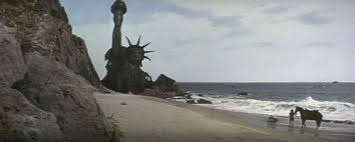I was at a cafe with a friend recently when he told me he had seen a film called Jason and the Argonauts made in 1963. This was his twelfth viewing and he was still excited. We both started talking about one thing - the special effects that were skeletons who would fight real humans with swords. They were the imagination of Ray Harryhausen, above.
One of the skeletons is above, and the real size. But when you see the movie, they are the same size as humans and vicious with the swords.
And they were all made of clay over frames.
Today, the basic millennial would probably either thing it was something dumb from the past or something really cool.
But there is one thing different from what we call CGI, or Computer Generated Imagery. While these effects are created by 1's and O's, Harryhausen's was real, to a sense. It was a real skeleton although the size that you see above.
What's the difference? It's real. You can hold it in your hand. It will last forever. You don't need to turn on a computer or smartphone.
Harryhausen first saw King Kong, which was the first big stop-action movie where King Kong was also a small gorilla but huge on the big screen. I think most people have heard of the movie and a lot who saw it.
But CGI addicts say that the effects aren't as good, sure they're okay for ancient movies but nothing like CGI.
But ultimately, both CGI and stop-action (they would shot one frame of film for each movement which took days and days) gave the audiences a thrill.
So ultimately both formats worked.
But there were also other methods used in the days of film. There were a lot of movies, especially westerns, where entire cities and mountains were set in the background. They were made by painting on glass.
One of the best was Albert Whitlock, who created this entire scene by painting on glass.
And again, you can see this and other mattes in museums, especially in the Academy Award offices, where they have displays now and then. It's not 1's and O's.
So what you're saying now is, "so what? It looks the same as CGI.'
But the difference is that humans actually created mattes and little skeletons that scared the hell out of me, and they were real things, that you can touch.
And the scene on the beach where Charlton Heston realizes that the planet of the apes is really Earth. This shot was filmed at Zuma Beach near Malibu and what's left of the statue of Liberty was painted in on glass.
I know that CGI is almost perfect in replicating humans and Mars and anything else. And the last Apes movie was incredible. But the key was that it had a good story. Not as good as the first Ape movie but close.
But one thing is missing in the new CGI-laden movies is that they're beginning to get boring because they're too good. I watched Mad Max but wasn't really as thrilled as the 2nd Mad Max which didn't have any CGI, while the new Max claimed to be mostly real, they had CGI also.
So ultimately it doesn't matter, a new generation will like it's special effect and the older generation manages to still "remember when we first saw King Kong..."
But there is a mechanical feel to CGI, I know there's hundreds of people who create images from dots but there's something about watching an image that you knew one or two people actually painted it on glass.
Or twisted wire with clay and created King Kong.
Maybe I'm just another boomer whining, but there is a greater feel I think, for something that is tangible, rather than 1's and O's.
I do like CGI for what it can do but I try to remember the guys who took wire and clay and made stories that people cried over.
Maybe it's what reality will be in the future or sooner. The thing is, every movie generation thinks their movies had the best effects. I guess it's like mom's cooking over Chipotle.
Regardless, we all go along with CGI and stop-action animation and matte paintings, none of it is real.
Even Kong had to die.

.jpg)






It's the same with music; people these days like MP3 but the quality is terrible. It's 1/11 of the sound of a vinyl record and has been compressed so much that it's impossible to hear two people singing the same note or playing the same note on an instrument - but people these days prefer it to Vinyl because of its accessibility. But going on to the glass in movies: one of my favourite uses of glass was in Bringing Up Baby (1938) when a leopard was the other side of the glass from Cary Grant and, with the use of a matt made them look next to each other.
ReplyDelete